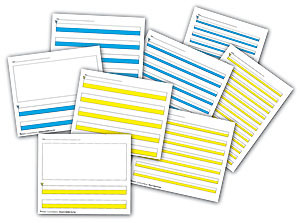Did you know that up to 50% of children in classrooms experience visual challenges—most commonly with eye tracking? These difficulties can significantly impact reading and writing, especially as children begin to learn handwriting.
To address this issue, therapists began highlighting the bottom line of traditional lined paper to show children where their letters should go. Recognizing the need for a more effective and consistent solution, Therapro created Highlighter Paper—a simple yet powerful tool designed to support children with visual tracking and handwriting challenges.
What Makes Highlighter Paper Unique?

Highlighter Paper features a visually distinct bottom line to help guide letter placement. To support correct letter formation and left-to-right orientation, the paper is indented at the starting point and includes a star icon to clearly indicate where to begin writing.
The paper comes in various formats and line widths to support children at different stages of handwriting development. Some styles also include space to draw a picture, with lines below for writing a description—ideal for creative storytelling or early literacy activities.
Choosing the Right Paper
Highlighter Paper is available in yellow or blue backgrounds and comes in four formats, each designed to support a specific stage of handwriting development:
- Kindergarten Story Paper: Landscape format with a blank space for drawing and two lines for writing
- Kindergarten Writing Paper: Landscape format with five writing lines
- WideLine Writing Paper: Landscape format with seven writing lines
- NarrowLines Writing Paper: Portrait format with 13 lines for more advanced writers
Not sure which to choose?
For early writers, especially in the first half of first grade, we recommend starting with wider lines. As handwriting skills progress—typically by the second half of first grade—children gain more motor control and can transition to narrower lined paper.
Additional Support: Reading Guide Strips
Therapro also offers Reading Guide Strips—simple tools with a transparent, tinted window to help children visually track lines of text while reading. These can be a helpful addition for children with visual tracking difficulties, especially during early literacy instruction.
